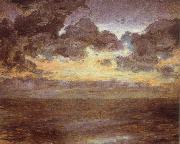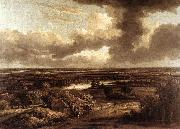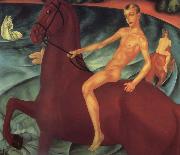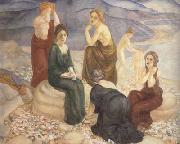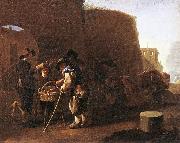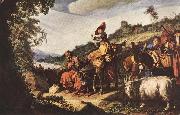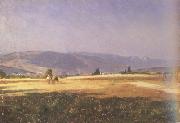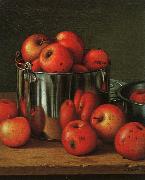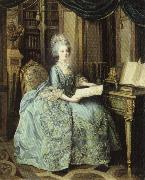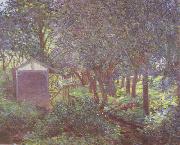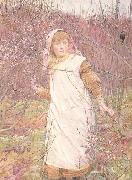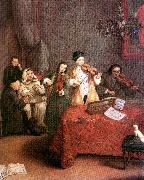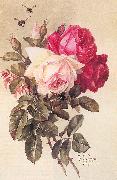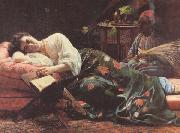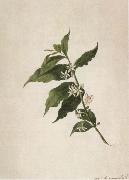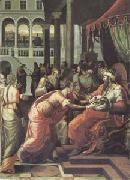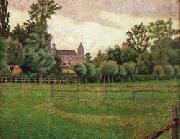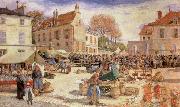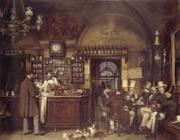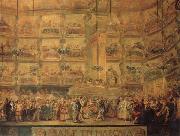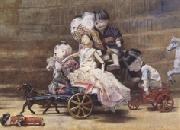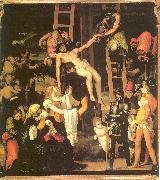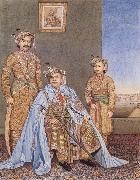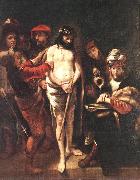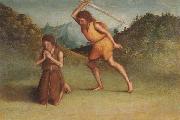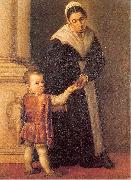|
|
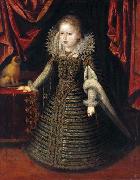 |
Juan Pantoja de la Cruz
|
|
(Valladolid, 1553 - 26 October 1608, Madrid) Spanish painter, one of the best representatives of the Spanish school of court painters. He worked for Philip II and Philip III. The Museo del Prado contains examples of his severe portraiture style.
Juan Pantoja de La Cruz was, born 1553 in Valladolid. Very little is known of his formative years as a painter. He was a pupil of the court painter Alonso Senchez Coello in Madrid and he must have assisted his master in complying with his duties as painter of the Spanish King, Philip II. Pantoja probably continued to work in his master studio after completing his training. He married in 1585 beginning to paint for the court around that time. After Sanchez Coello's death in 1588, Pantoja took over his master workshop and became court painter to Philip II of Spain.
Pantoja kept working for the court and the nobility, painting portraits of Prince Philip, the future Philip III, in 1592 and 1594. Among his most well known works is the portrait of Philip II wearing a cape and hat all in black, painted around 1594 for the Escorial. This portrait is one of the best representations of the idea of Spanish majesty, based on the remoteness of the monarch. On Philip II's death in 1598, Philip III confirmed Pantoja's status as court painter. When the court settled in Valladolid in 1601, Pantoja moved to the new capital, remaining in this city, several years. |
|
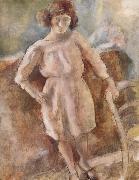 |
Jules Pascin
|
|
Bulgarian-born French Expressionist Painter, 1885-1930 |
|
|
|
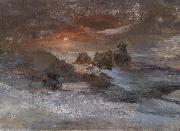 |
Julius Payer
|
|
Julius Johannes Ludovicus Ritter von Payer (2 September 1841 - 19 August 1915) was an Austro-Hungarian arctic explorer and an Arctic landscape artist.
Born Julius Payer, his father Franz Anton Rudolf Payer was a retired officer who died when Julius was only fourteen. Payer attended k.k. cadet school in Lobzowa near Krakew (now Poland). Between 1857 and 1859 he studied at the Theresian Military Academy in Wiener Neustadt (near Vienna). In 1859 he served as a sub-lieutenant with the 36th. infantry regiment in Verona, Northern Italy. He participated in the 1859 Battle of Solferino. Between 1860 and 1863 he served at the garrison in Verona, Italy. In 1863 Payer was assigned as a history teacher to the cadet school in Eisenstadt, Austria. After promotion to the rank of lieutenant first class he was posted to the garrison of Venetia.
In 1862 he started exploratory tours of the Italian Alps and Hohe Tauern in his free time. From 1864-1868 he explored the Adamello-Presanella Group and the Ortler Alps. He was the first to climb Adamello (3554m). His tours resulted in creating a detailed topographical map at a scale 1:56,000. Due to his achievements, Payer was transferred to the Austrian Military Cartographical Institute in Vienna.
|
|
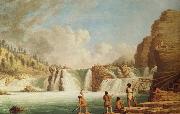 |
Kane Paul
|
|
Irish-born Canadian Painter
b.1810 d.1871
|
|
 |
Karel Purkyne
|
|
(1834-1868) was a Czech painter. He was one of the most prominent proponents of realism in Czech art in the second half of the 19th century. He was the son of the physiologist and anatomist Jan Evangelista Purkyne, and developed an interest in art while still young. Early influences included the Baroque painters Karel Škreta and Petr Brandl and the paintings of the Dutch Golden Age. He spent a year in Munich studying with Johann Baptist Berdelle before traveling to Paris, where he worked with Thomas Couture; there he copied paintings by Old Masters and encountered the work of contemporary French artists. He was particularly struck by the works of Gustave Courbet. Upon returning to Prague, Purkyne became known primarily as a portraitist, though a handful of works in other genres are known. He also made a name for himself as an organizer of artistic events and as an art critic.
|
|
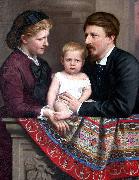 |
Karl Ernst Papf
|
|
Karl Ernest Papf (Dresden, Germany, 1833 -Sao Paulo, 1910) was a German painter, and draftsman that moved to Brazil in 1867.
He studied in the Academy of Fine Arts of Dresden and in 1867, was hired for the profession of photographer by the firm of his compatriot Albert Henschel. He initially worked in Recife until 1872, then in Salvador until 1877 - always in service of the atelier Albert Henschel & Cia., as written in Almanak Laemmert. He moved to Rio de Janeiro in surch for a better environment for the development of his work. |
|
 |
Karl Kaspar Pitz
|
|
painted Portrait of a cleric a book in his right hand, by a marble bust in before 1795 |
|
|
|
|
|
 |
Karl von Piloty
|
|
Karl Theodor von Piloty (1 October 1826 - 21 July 1886) was a German painter.
Von Piloty was born in Munich. His father, Ferdinand Piloty (d. 1844), enjoyed a great reputation as a lithographer. In 1840, Karl was admitted as a student of the Munich Academy, under the artists Karl Schorn and Julius Schnorr von Karolsfeld. After a journey to Belgium, France and England, he commenced work as a painter of genre pictures, and in 1853 produced a work, Die Amme (The Wet Nurse), which, on account of its originality of style, caused a considerable sensation in Germany at the time.
But he soon forsook this branch of painting in favour of historical subjects, and produced in 1854 for King Maximilian II The Accession of Maximilian I to the Catholic League in 1609. It was succeeded by Seni at the Dead Body of Wallenstein (1855), which gained for the young painter the membership of the Munich Academy, where he succeeded Schorn (his brother-in-law) as professor.
Among other well-known works by Piloty are the Battle of the White Mountain near Prague, Nero Dancing upon the Ruins of Rome (1861), Godfrey of Bouillon on a Pilgrimage to the Holy Land (1861), Galileo in Prison (1864) and The Death of Alexander the Great (unfinished), his last great work. He also executed a number of mural paintings for the royal palace in Munich.
For Baron von Schach, he painted the famous Discovery of America. In 1874, he was appointed keeper of the Munich Academy, being afterwards ennobled by the king of Bavaria. Piloty was the foremost representative of the realistic school in Germany. He was a successful teacher, and among his more famous pupils were Hans Makart, Franz von Lenbach, Franz Defregger, Gabriel von Max, Georgios Jakobides and Eduard von Gretzner. |
|
|
|
|
|
|
|
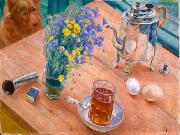 |
Kuzma Sergeevich Petrov-Vodkin
|
|
(1878, Khvalynsk, now Saratov OblasteFebruary 15, 1939, Leningrad) was an important Russian and Soviet painter and writer.
Kuzma Petrov-Vodkin was born in Khvalynsk (Saratov Oblast) into the family of a local shoemaker. His first exposure to art was in his early childhood, when he took some lessons from a couple of icon painters and a signmaker. Still, Petrov-Vodkin didn't quite see himself in art at that time; after graduating from middle school, he took a summer job at a small shipyard with plans to get into railroad college in Samara. After failing his exam, he turned to "Art Classes of Fedor Burov" in 1893.
In April 1895, Burov died and for some time Petrov-Vodkin took different painting jobs in the vicinity of Saratov. By chance, his mother's employer invited a well-known architect, R. Meltzer. Petrov-Vodkin was introduced to the guest and impressed him enough to get an invitation to study art at Saint Petersburg. The education was financed by a charitable subscription among local merchants. He also met at this time Borisov-Musatov, an important painter resident in Saratov, who encouraged Petrov-Vodkin to continue his studies.
Petrov-Vodkin stayed in Saint Petersburg from 1895 to 1897 studying at the Baron Stieglits School, before moving to the Moscow School of Painting, Sculpture and Architecture. There Petrov-Vodkin was a student of Valentin Serov, Isaak Levitan and especially Konstantin Korovin. In 1901 he travelled to Munich to take classes with Anton Ažbe.
He graduated in 1904.
|
|
|
|
|
|
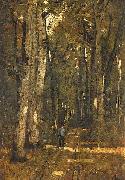 |
Laszlo Paal
|
|
Laszlo Paal (1846-1879) was a Hungarian Realist landscape painter. He was a pupil of Mihaly Munkacsy. His pictures are representative of lyrical realism: his oeuvre is related to the tendencies of the Barbizon School. |
|
|
|
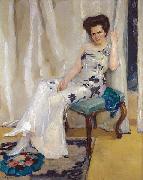 |
Leo Putz
|
|
Germany (1869 -1940 ) - Painter
|
|
|
|
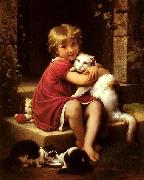 |
Leon Bazille Perrault
|
|
(20 June 1832, Poitiers - 1908, Royan) was a French painter.
A student of William Bouguereau and François-Edouard Picot, he exhibited at the Salon from 1863 onwards, producing several works, in the academic tradition. He was famous for his le petit naufrag (The little shipwrecked boy, 1874) and his paintings of children.
|
|
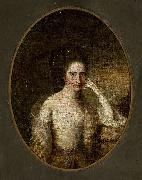 |
Leonor de Almeida Portugal
|
|
Leonor de Almeida Portugal de Lorena e Lencastre (Lisboa, 31 de outubro de 1750 - Benfica, 11 de outubro de 1839) foi uma nobre e poetisa portuguesa. |
|
|
|
|
|
|
|
|
|
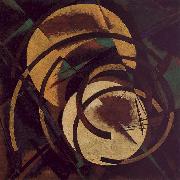 |
Ljubov Popova
|
|
Russian Constructivist Painter and Designer, 1889-1924 |
|
|
|
|
|
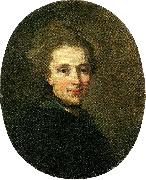 |
lorens pasch d. y
|
|
Lorens Pasch d.y., född 1733, död 1805, konstnär; professor vid Konstakademien från 1773. Son till Lorens Pasch d.ä., bror till Ulrika Pasch, brorsson till Johan Pasch. Invald tillsammans med sin syster i Konstakademien 1773. |
|
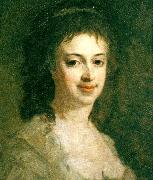 |
lorens pasch d.y
|
|
Lorens Pasch d.y., född 1733, död 1805, konstnär; professor vid Konstakademien från 1773. Son till Lorens Pasch d.ä., bror till Ulrika Pasch, brorsson till Johan Pasch. Invald tillsammans med sin syster i Konstakademien 1773. |
|
 |
Lorens Pasch the Younger
|
|
(1733-1805) was a Swedish painter
He grew up in an artistic family (he was the brother of Ulrika Pasch, alongside whom he was elected to the Art Academy in 1773), but his father Lorens Pasch the Elder wanted him to become a priest. He was thus sent to study in Uppsala aged 10. However, he decided on an artistic career after all and began an apprenticeship in his father's studio before going to Copenhagen, with introductions from his wealthy and influential uncle Johan Pasch. There he studied painting for three years in the studio of Carl Gustaf Pilo. Despite good offers of studio-apprenticeships and commissions from Sweden, he then set off for Paris in 1758 to complete his artistic education. There he specialised in history painting in the studios of Eustache Le Sueur and François Boucher (though for financial reasons he also continued his training in portraiture) and became friends with fellow-Swede Alexander Roslin.
In 1764 he left Paris and got back to Sweden in 1766. He fully completed his training in the studio of the French painter Guillaume Taraval, who in 1735 founded the Royal Swedish Academy of Arts in Stockholm. Soon after his arrival back in Sweden Pasch's gained a great reputation as a portraitist, gaining favour and commissions from the royal court and gaining the esteem of Adolf Frederick, King of Sweden and his queen Louisa Ulrika - one of his most notable works is his Portrait of Louisa Ulrika of Prussia. He served as a professor at the Academy of Arts from 1773 to his death, becoming its director on Pilo's death in 1793. At the end of his life he concentrated more on training young artists and managing the Academy than on painting. He died unmarried in 1805 and due to his powerful portraits remains one of the most respected painters of the Gustavian era in Sweden. |
|
|
|
 |
Louis-Philippe Crepin
|
|
(1772-1851) was a French naval painter, one of the first Peintres de la Marine.
Crepin was notably a pupil of Joseph Vernet and Hubert Robert.
His Combat de la Bayonnaise contre l'Ambuscade, 1798, depicting the Action of 14 December 1798, is one of the main exhibits of the Musee national de la Marine.
|
|
|
|
|
|
|
|
|
|
|
|
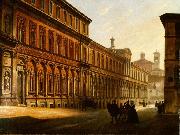 |
Luigi Premazzi
|
|
(Milan, 1814 - Istanbul, Turkey, 1891) was an Italian painter.
Premazzi attended the Brera Academy of Fine Arts and then the private school run by Giovanni Migliara. His early watercolours, based on the works of his master, were produced for the lithographic industry. His oeuvre is characterised by a repertoire of urban views produced in accordance with the dictates of perspective painting. While most of these are set in Milan, other Italian cities were also featured in later years. His smooth, precise painting also shows the influence of his contemporary Luigi Bisi in its descriptive focus on architectural detail. He presented work regularly at the exhibitions of the Societe Promotrice di Belle Arti in Turin from 1842 to 1848 as well as those of the Brera Academy. Having moved to Saint Petersburg around 1850, he became a teacher at the Imperial School of Fine Arts there in 1861. Frequent stays in the Caucasus and the Middle East provided new subjects for his paintings, which he continued to send to Italian exhibitions, where they aroused wonder and curiosity.
|
|
|
|
|
|
 |
Mabel Pryde
|
|
(February 12,1871, Edinburgh - July 1918, England.) was an artist, best known for being the wife of artist William Nicholson and mother of artists Ben Nicholson and Nancy Nicholson and the architect Christopher 'Kit' Nicholson.
Mabel was the daughter of David Pryde, Headmaster of Edinburgh Ladies College 1870-1891, and Barbara Lauder, whose father William was a brother of the famous Scottish artists Robert Scott Lauder and James Eckford Lauder. Mabel had one brother, the artist James Pryde. As children they lived at 10 Fettes Row, a north-facing Edinburgh house.
Pryde trained at the Bushey School of Art under the tutilage of Hubert von Herkomer. Here she met fellow student William Nicholson whom she married in 1893. She introduced Nicholson to her brother James and all three moved to Eight Bells, Denham, Buckinghamshire, where Nicholson and James Pryde would collaborate on the famous series of lithographic posters they disseminated under the pseudonym J. & W. Beggerstaff.
Pryde and Nicholson had four children - Ben (1894-1982); Anthony (1897-1918) who was killed in action during the First World War; Annie Mary "Nancy" (1899-1978), and Christopher "Kit" (1904-1948). In July 1918 Pryde died from influenza in during the 1918 flu pandemic and was survived by her husband.
|
|
|
|
|
|
|
|
|
|
|
|
|
|
|









